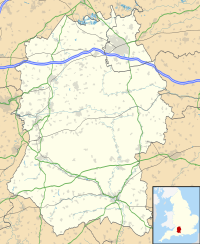 Viewed from the south | |
| Location | near Nettleton, Wiltshire |
|---|---|
| Coordinates | 51°30′20.520″N 2°14′43.188″W / 51.50570000°N 2.24533000°W |
| OS grid reference | ST 83069 78559 |
| History | |
| Periods | Early Neolithic |
| Designated | 10 August 1923 |
| Reference no. | 1010397 |
Lugbury Long Barrow is a prehistoric long barrow in Wiltshire, England, about 0.6 miles (1 km) east of Nettleton and about 1 mile (1.6 km) north-west of Castle Combe. The site, excavated in the 19th century, is a scheduled monument.[1]
Description
[edit]The monument is one of many long barrows in Dorset, Hampshire and Wiltshire. Dating from the early to middle Neolithic periods, they are the burial places of early farming communities.[1]

The mound, on level ground, is orientated west–east. The size of the mound before excavation is thought to have been about 209 by 78 feet (64 by 24 m). Flanking ditches north and south of the barrow, from which material for the mound was originally taken, have been filled in over the years. Towards the eastern end are the remains of a chamber: a capstone, about 12 by 6 feet (3.7 by 1.8 m), leaning against two upright stones (all of limestone), which formed the false entrance portal to the mound.[1][2][3]
Excavation
[edit]It was partially excavated in 1821 by Richard Colt Hoare. He made a trench along the barrow, and found near the eastern end at ground level the skeleton of a young man in a crouched position.[1][2][3]
George Julius Poulett Scrope excavated the site in 1854 to 1855, and a report was written by John Thurnam. Four burial chambers were found, three of which contained a total of twenty-six skeletons of adults and children of both sexes. Some flint flakes were found.[1][2][3]
References
[edit]- ^ a b c d e Historic England. "Long barrow 500m north of Lugbury Farm (1010397)". National Heritage List for England. Retrieved 3 September 2023.
- ^ a b c Richard Wainwright. A Guide to the Prehistoric Remains in Britain. Volume 1: South and East. Constable, 1979. Page 174.
- ^ a b c Historic England. "Lugbury Long Barrow (208304)". Research records (formerly PastScape). Retrieved 6 September 2023.
External links
[edit] Media related to Lugbury Long Barrow at Wikimedia Commons
Media related to Lugbury Long Barrow at Wikimedia Commons
